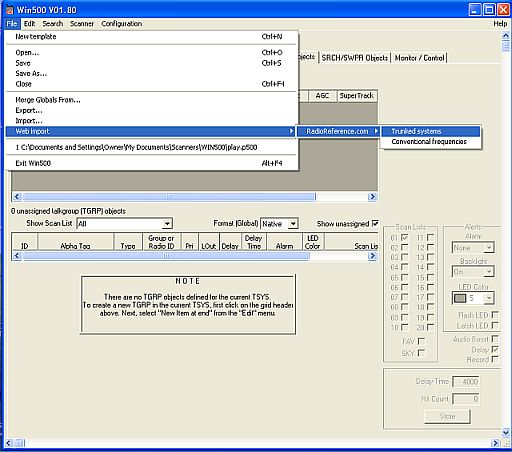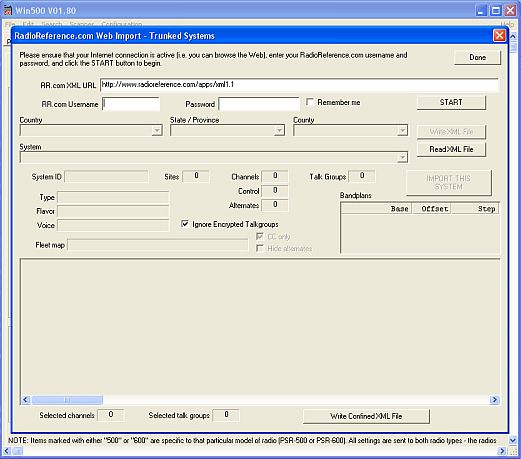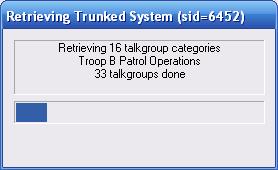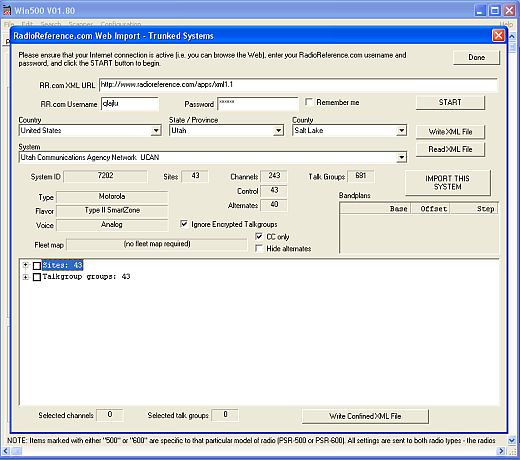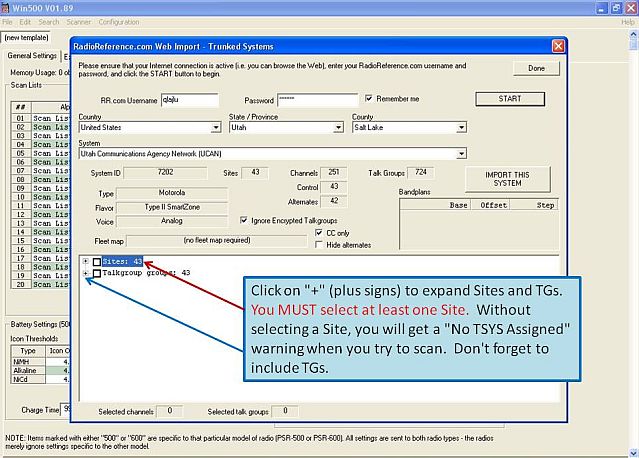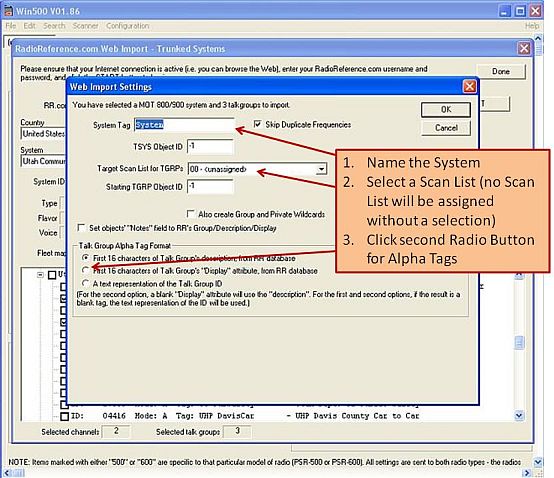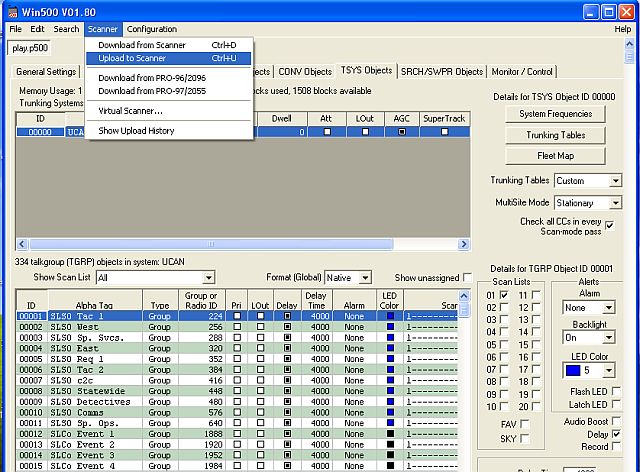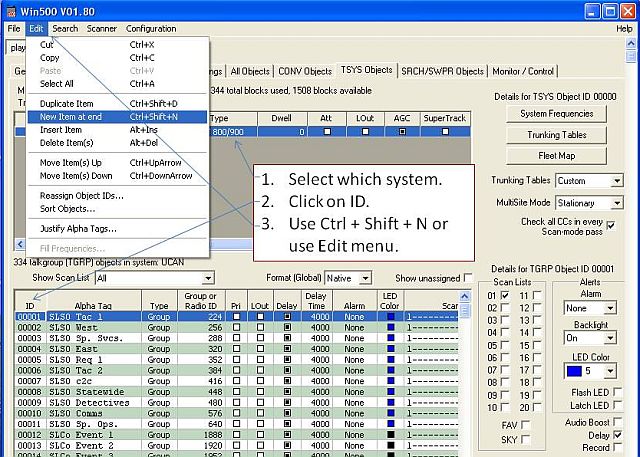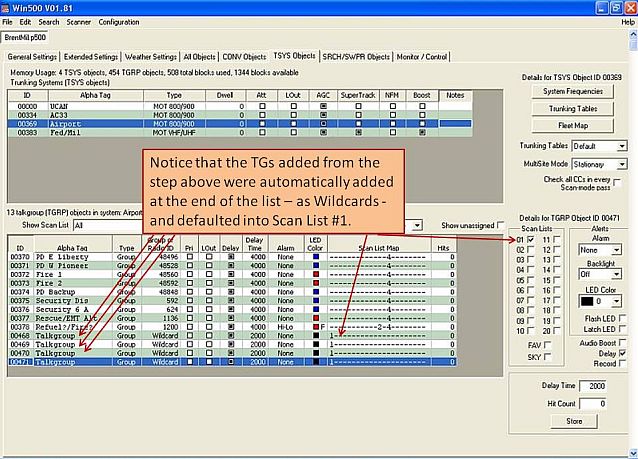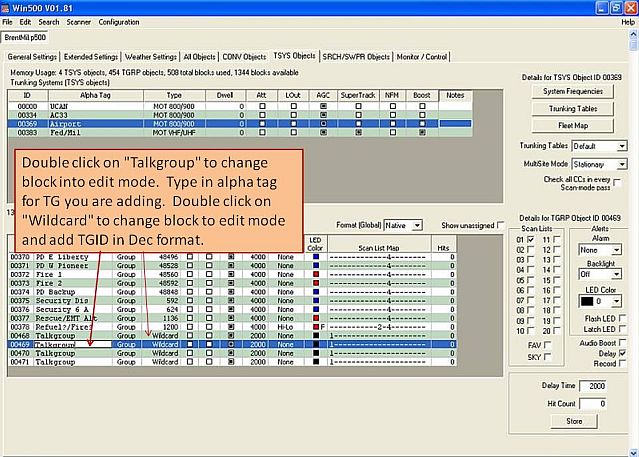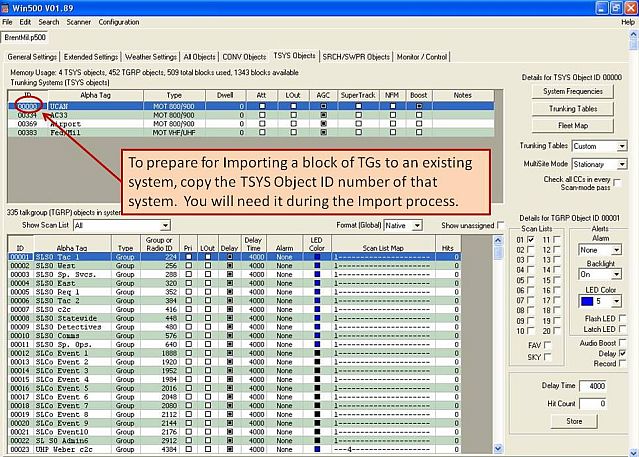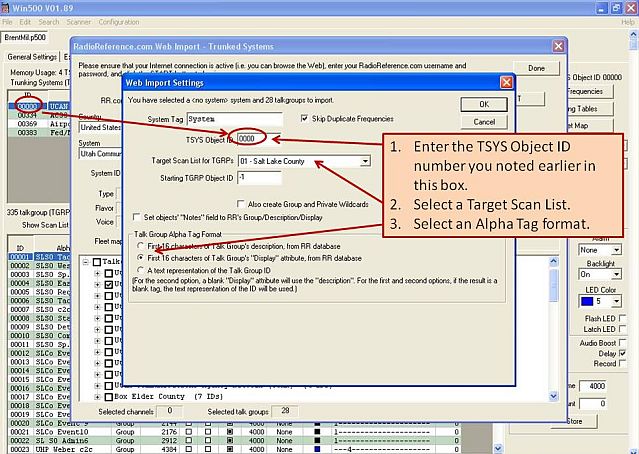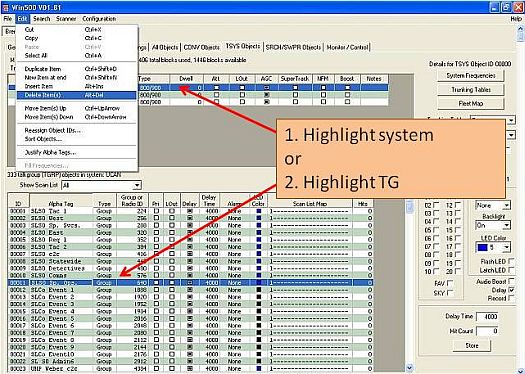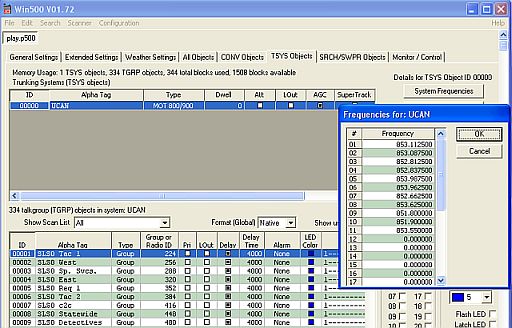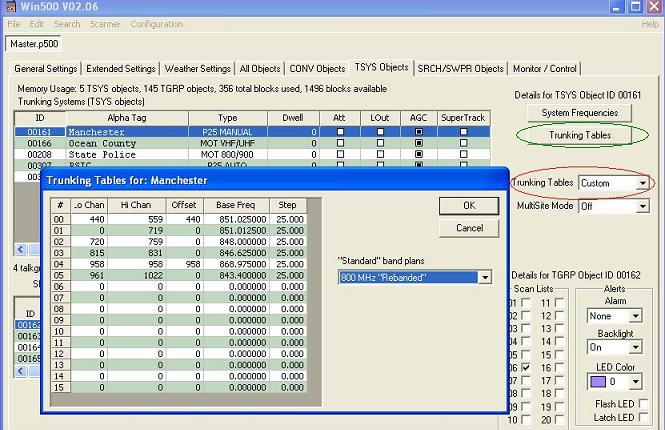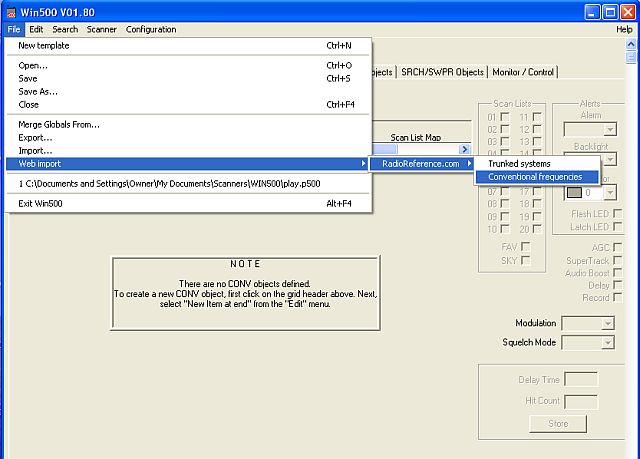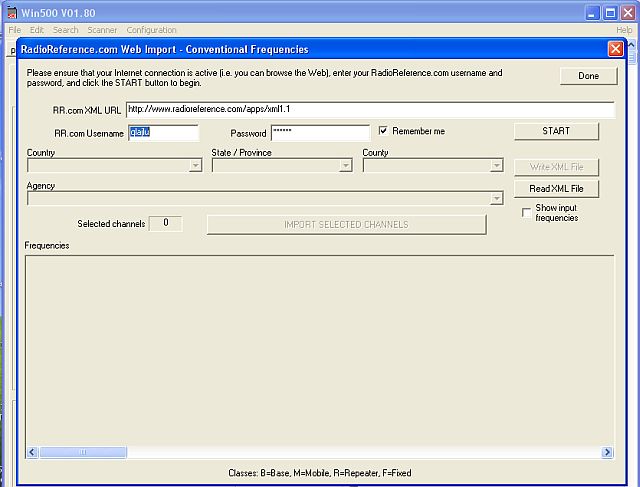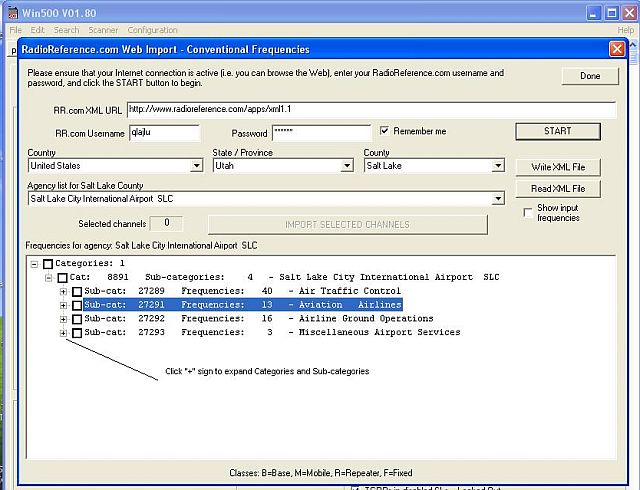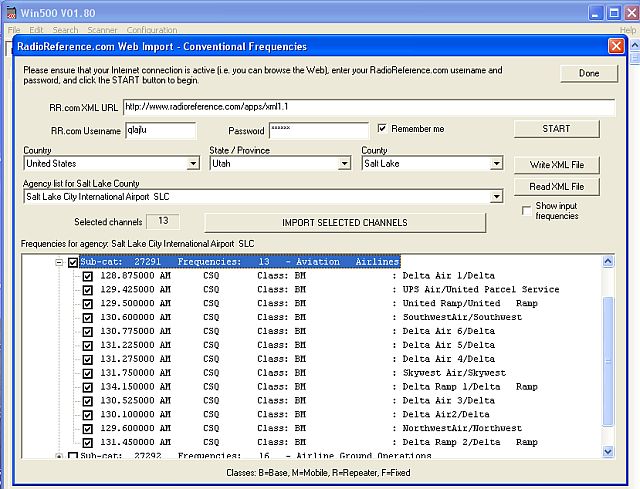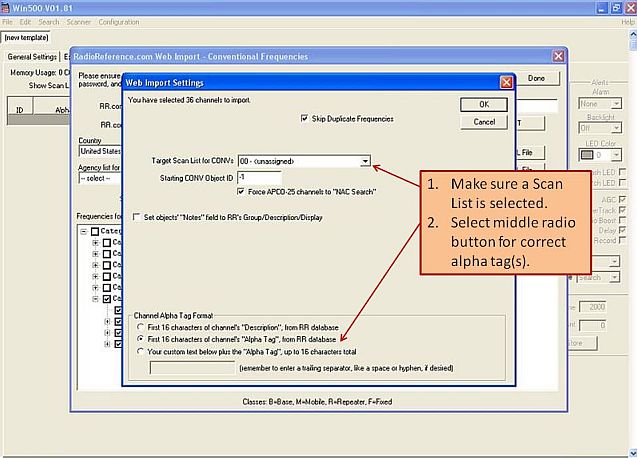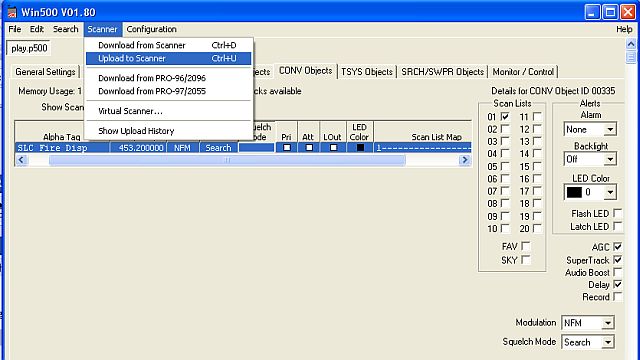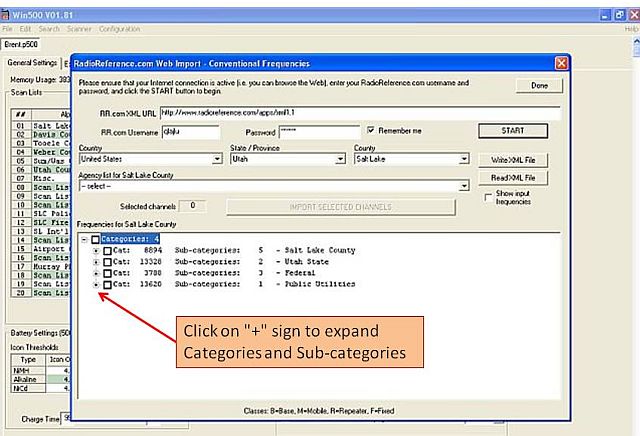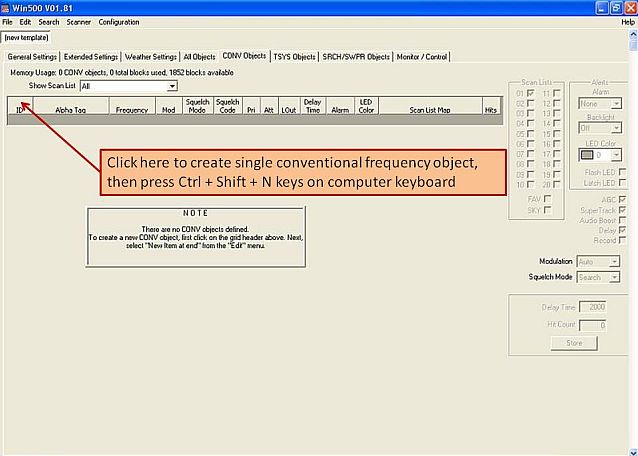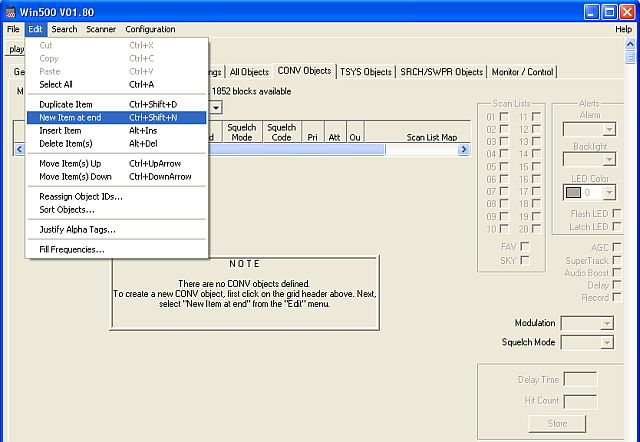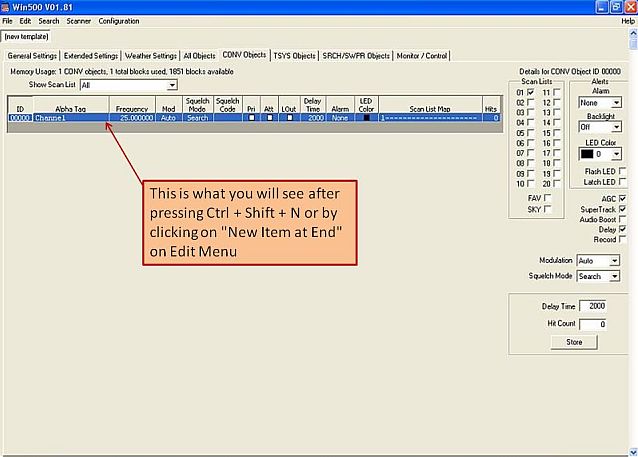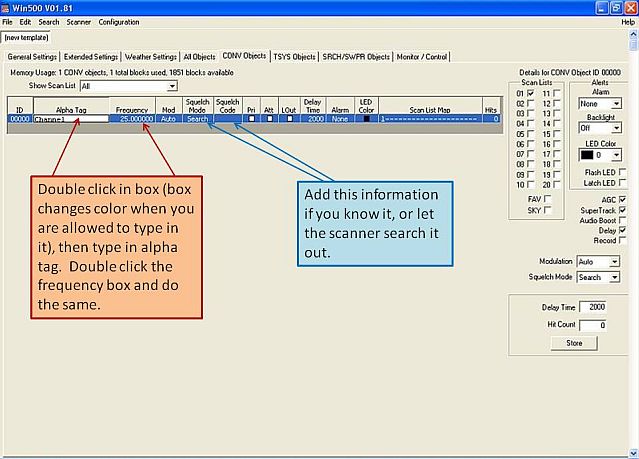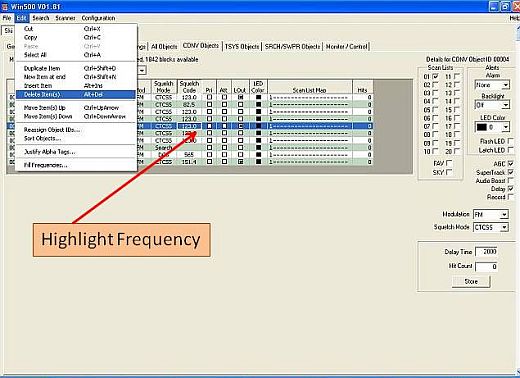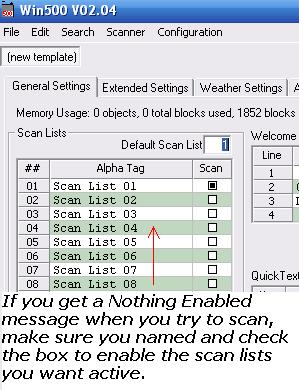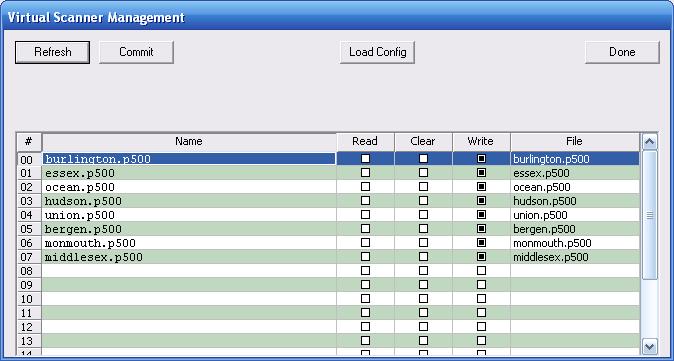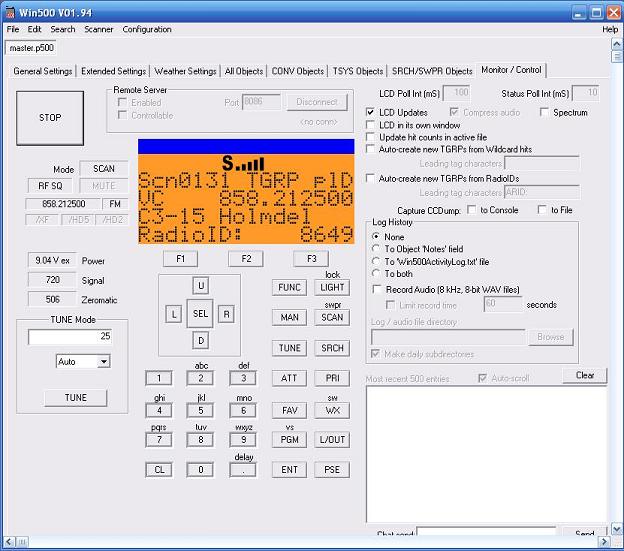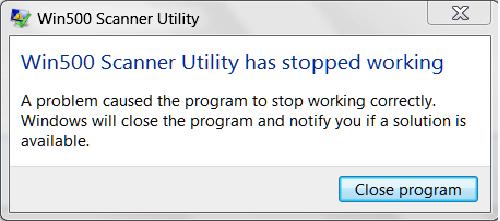WIN500
IMPORTANT ANNOUNCEMENT (13 MAR 2021)
The Utah Communications Agency Network (UCAN) and the Utah Communications Authority (UCA) will be decommissioning the current 800Mhz Motorola trunking system by the end of 2023 (now expected in August - November 2024). UCAN is the main Public Safety trunked system used throughout the state of Utah and is one of the largest systems in the nation. Over 100 Motorola Trunking sites will be shut down and replaced with an all-digital P25 system using 700Mhz. It will impact all Utah public safety and services agencies. After the change, a large body of the information on this site will be out of date.
THIS SITE WILL BE GOING AWAY AFTER THE TRANSITION IS COMPLETE (Q3 2024).
Your scanner or radios must support P25 digital and will need to be reprogrammed to continue to hear anything on the new system. The community isn't sure how much of the traffic will be encrypted after the switch. If regular channels are encrypted, it will become illegal to attempt to monitor that traffic. We can only hope that if the UCA chooses to do this, they will offer time-delayed or filtered streams of radio transmissions to the public. The public has a special interest in monitoring the activity and operations of public safety agencies. Recent documented abuses by law enforcement officers who have covered up activities or mistakes by abusing laws originally meant to protect victims are a prime example.
Please copy any information you want or need from this site prior to December, 2022. For additional details see the RadioReference Utah forum. An effort is underway to save some content on the RadioReference Utah wiki: https://wiki.radioreference.com/index.php/Utah_(US).
73 de N2OW,
-Ryan
Using WIN500 to populate a scanner
Please go to Starrsoft.com for instructions and updates.
WIN500 (Latest Version 2.08) is a Data Management, Monitoring and Control Software for the following scanners:
GRE PSR500 - PSR600 - PSR310 - PRS410 ..... Whistler WS1040 - WS1065 ..... Radio Shack PRO106 - PRO197 - PRO651 - PRO652
NOTE: Importing from the Radio Reference Database will not work if you are not a Premium Subscriber to the Radio Reference Web site.
Trunked Systems
Open or Closed Mode - "Wildcard"
It is considered scanning in "Open Mode" if there is a Wildcard in working memory while scanning. A Wildcard allows reception of radio traffic from any active Talk Group in a trunked radio system. "Closed Mode" occurs when there is not a Wildcard in working memory, or the Wildcard is locked out so scanning is limited to specific Talk Groups.
Importing Trunked Systems and Talk Groups
1. To Import from Radio Reference, click File > highlight Web Import > RadioReference.com > select Trunked Systems.
2. On the next page enter your credentials for logging into the Radio Reference Web site then click on "START."
3. Using the drop-down menus, select the Country, State/Province, County, and System. It now takes a some time for the software to collect the data so be patient.
When completed you'll be able to continue.
4. Click on the "+" signs to expand the Site(s) and TGs available for the system selected in the step above placing a check mark for those Sites and TGs you want to import. You must select at least one Site to Import along with the TGs or you will get a "No TSYS Assigned" warning when you begin to scan.
5. Click on "IMPORT THIS SYSTEM." (Any site or TG without a check mark will not be imported, so check them over before proceeding.)
WARNING NOTE:
- The scanner is limited to a total of 32 frequencies for a trunking system. That means that no more than 32 Control Channel frequencies or a combination of Control Channel frequencies and Alternate Control Channel frequencies can be entered per system. If all the frequencies in use on a particular site are entered, that will reduce the number of sites you will be able to enter in that system.
In an EDACS or LTR Standard system, each Site will have to be its own system. Since all the frequencies must be imported in these types of systems (instead of just a Control Channel as in a Motorola system), and since the frequencies must be in LCN order, frequencies from different sites CANNOT be mixed in the same TSYS frequency list.
Assigning Objects to Scan List
6. In the Import Settings Dialog box (shown below)...
- a. Give a unique name to the system you are importing.
- b. Select a Scan List assignment (without this, the TGs will not be assigned a Scan List and when you start to scan you will get a "Nothing Enabled" warning).
- c. Select the second (middle) radio button to get the correct alpha tags imported with the TGs you have selected in the previous step.
7. Click "OK" then click "Done." The software will now import the system(s) and/or TGs you have selected to the WIN500 software.
Repeat the above process until all the Trunked Systems you want to import are displayed in Win500, then procede to the next step.
Please Read: If there are conventional frequencies you want to add to your programming for uploading to your scanner, go to the section titled Conventional Frequencies and follow the instructions for adding those.
NOTE: At this point it would be a good idea to check the TGs that were imported and make sure the Scan List Map shows numbers indicating the TGs have been assingned a Scan List. If the TGs are not in a Scan List, you will get a "Nothing Enabled" warning when you begin to scan. The Scan List assignment box on the right side of the TG list is where you can assign each TG to a Scan List. You can highlight a group and only make one selection for the whole group or you can assign each one individually.
8. To upload the data imported from the Radio Reference Database to the scanner, click on Scanner > Upload to Scanner. The scanner will reboot itself and then should start scanning automatically after uploading. If not, press SCAN. You might also have to press the number 1 key on the scanner to enable the #1 Scan List. Everything you want in your scanner has to be done in one upload, make sure you have all the Trunked Systems and Conventional Frequencies showing in Win500 before you upload the information.
9. Click on File (upper left corner) > Save As... and save this information to the WIN500 folder on your computer as whatever.p500.
Adding Individual TGs
These images show how to add individual or specific TGs.
1. After selecting the TSYS Objects tab, select the system above the window where you want to add the TG(s).
2. Click on "ID" below the window. If you do not click below the window, when you do the next instruction a new System will be added above the window instead.
3. Use Ctrl + Shift + N on computer keyboard or click on Edit > New Item at End. The TG added will be a Wild Card TG and can be scanned as a Wild Card or you can edit it to make a specific TG by changing the information in the fields on that line (ID numbers will be assigned by the program automatically).
4. Repeat as necessary to add as many individual/specific TGs as you want.
5. This image shows what it looks like after adding four additional spaces for TGs. Even though the text in the image says the added TGs will default to Scan List 1, that no longer may be the case with the newest updates to the WIN500 software since Aug. 1, 2009. Be sure to check the Scan List assignment.
6. Double click "Talkgroup" in the Alpha Tag field to change it for editing and type in the alpha tag you want to use for that TG. Then double click "Wildcard" in the Group or Radio ID field and add the TGID in DEC format. You can always leave one as a Wild Card TG, too.
7. Make sure these new TGs are in the scan list where you want them, then upload the changes to the scanner and save them to your WIN500 file on your computer.
Adding a Block of TGs to an Existing System
So you want to add more than one or two TGs to an existing system in your scanner. How to do it the least painful way using WIN500? The easiest way to add a block of TGs to a system that has been previously imported is to do another import from RR.com only with a couple of very small but critical changes.
1. Before you start your import, open WIN500 and look at the TSYS Object ID number of the system where you want to add the TGs. That ID number was automatically assigned by WIN500 when the system was originally imported. Make a note of that number (see image below).
2. When you get to the page shown below, only expand the Talk Groups because you are not importing a system. Place a check mark by each of the TGs you wish to add to the existing system in your scanner.
3. At the Web Import Settings page enter the TSYS Object ID number (that you noted earlier) into the "TSYS Object ID" box replacing the default of "-1". Also make a scan list assignment and select the Alpha Tag format you desire.
4. Click "OK" and "Done." Click on the TSYS tab and scroll to the bottom. Your new TGs will be there at the bottom of the list. Upload to your scanner and save the changes to your whatever.p500 file on your computer.
Deleting Systems and/or TGs
1. Highlight the System or the TG to be deleted.
2. Click on the Edit menu.
3. Click "Delete Item(s)" on the menu or use Alt + Del on the computer keyboard.
Edit Control Channel Frequencies
To edit the Control Channel frequencies click on the TSYS Objects tab > click on the System Frequencies bar. After rebanding, all that is necessary is editing the CC frequency as long as a custom band plan is programmed into the scanner.
WARNING NOTE: The scanner is limited to a total of 32 frequencies for a trunking system. That means that no more than 32 Control Channel frequencies or a combination of Control Channel frequencies and Alternate Control Channel frequencies can be entered per system. If all the frequencies in use on a particular site are entered, that will reduce the number of sites you will be able to enter in that system.
Custom Band Plan (Trunking Tables)
To edit or install a Custom Band Plan (Trunking Tables), click on the TSYS Objects tab > click on the Trunking Tables bar, and when the next window opens, click the drop-down menu and select the appropriate band plan > click OK. For the 800 MHz trunking systems select 800 MHz Rebanded. This band plan or trunking table will be good for systems already rebanded as well as those not yet rebanded.
Also, you'll see another Trunking Table setting below the one where you just set the table, make sure you change the default setting to "Custom".
Conventional Frequencies
Importing Conventional Frequency Systems
1. To Import from Radio Reference, click File > highlight Web Import > RadioReference.com > select Conventional frequencies.
2. On the next page enter your credentials for logging into the Radio Reference Web site then click on "Start."
3. Using the drop-down menus, select the Country, State/Province, County, and System.
4. Click on the "+" signs to expand the Categories and Sub-categories available for the system selected in the step above placing a check mark for those you want to import.
5. Click on "IMPORT SELECTED CHANNELS." (Any frequency without a check mark will not be imported so check them over before proceeding.)
Assigning Objects to Scan List
6. On the next page, select the second (middle) radio button to get the correct alpha tags imported with the frequencies you have selected in the previous step. Also make sure that a Scan List is selected or the message, "Nothing Enabled" will be the result.
7. Click "OK" then click "Done." The software will now import your selected frequencies to the WIN500 software. Repeat the above process until all the conventional frequencies you want to import are displayed in Win500, then procede to the next step.
NOTE: At this point it would be a good idea to check the frequencies that were imported. In the past, they have all been defaulted into Scan List 1, but with recent changes in the software, it is possible that they were not assigned a Scan List at all. The Scan List assignment box on the right side of the frequency list is where you can assign each frequency to a Scan List. You can highlight a group and only make one selection for the whole group or you can assign each one individually.
8. To upload the data imported from the Radio Reference Database to the scanner, click on Scanner (menu at top of page) > Upload to Scanner. Everything you want in your scanner has to be done in one upload, make sure you have all the Trunked Systems and Conventional Frequencies showing in Win500 before you upload the information.
9. Click on File (upper left corner) > Save As... and save this information to the WIN500 folder on your computer as whatever.p500.
Conventional Frequencies NOT belonging to a System
Some conventional frequencies do not belong to a system and are organized in the Radio Reference Database as Categories and Sub-categories only. To access them, after selecting the County wait just a few seconds. Categories and Sub-categories will appear in the large window. Simply click on the "+" sign to expand them, then place a check mark by those frequencies to be imported. After placing the check marks, follow instructions 5 through 9 above for importing conventional frequencies.
Adding Individual Conventional Frequencies
These images show how to add an individual or specific frequency.
1. After selecting the Conventional Objects tab, click on "ID" (See image) then Ctrl + Shift + N on your computer's keyboard.
2. You can also click on the Edit menu at the top of the page and then click on "New Item at end" instead of using the keyboard shortcut.
3. A new Conventional Frequency Object will be created by each use of the keyboard shortcut or clicking on the Menu command. The new Conventional Object will be added to the END of the list if other objects already exist.
4. Double click the field to open it for editing. Fill the fields in manually after creating the space to accept the new frequency (ID will be automatically assigned by the program). CTCSS, DPL, or DCS tones can be added manually if known, or allow the scanner to seek them out by leaving the Squelch Mode in "Search."
5. Repeat as necessary to add as many individual/specific frequencies as desired.
Deleting Conventional Frequencies
1. Highlight the frequency(ies) to be deleted.
2. Click Edit on the menu.
3. Click on "Delete Item(s)" or use Alt + Del keys on computer keyboard.
Finished Importing - Uploading info to your Scanner
After importing the info from RadioReference into Win500, remember to save your work (give it a name) then you can upload that info using the "Upload to Scanner" option under the Scanner Tab in Win500. Make sure after making changes to your saved file, upload those changes you make in your software to the scanner and to save that change or changes to your WIN500 folder on your computer. Each time you upload to your scanner it will over-write what is in the scanner.
"Nothing Enabled"
When you turn your scanner on you should get the "Welcome Screen," then you should see the following screen (there may be more numbers showing depending on how many scan lists are created by the user):
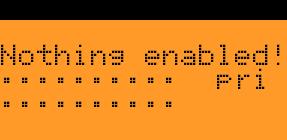
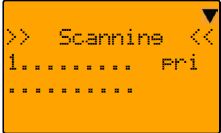
When the objects are imported to the WIN500 programming software you must select a Target Scan List. In prior versions of WIN500, objects imported were defaulted to Scan List 1, but with recent updates that no longer occurs. You must have objects assigned to a Scan List or you will get "Nothing Enabled." If you are seeing "Nothing Enabled," press the number 1 key on the scanner's key pad. If that does not work, open your WIN500 program and check to see if the objects are, indeed, assigned to a Scan List. If they are not, assign them and then upload to the scanner again. Be sure to save any changes to your whatever.p500 file on your computer.
Toggling Scan Lists
To toggle scan lists off or on, use the number keys on the scanner's keypad. Scan Lists 1 - 10 are toggled by using numbers 1 - 0, and Scan Lists 11 - 20 are toggled by pressing the FUNC key and then a number 1 - 0 (i.e. FUNC + 3 = Scan List 13).
Virtual Scanner Management (V-Folders)
Virtual Scanner Management is a tool that will let you select from 1 to 20 .P500 files and send them all to the scanner V-Folders. This will not effect the working memory of your scanner. At the end of the process the scanner will reboot and scan your working memory.
In Win500 top left hand corner, click on the Scanner then click on Virtual Scanner, also you'll need the programming cable connected to use this function, you can Read, Clear, or Write to a V-Folder(s).
Hit Refresh (Remote V-Scanner Mode) first, then as the above screen shows you check Write another screen will appear (Win500 Directory) and you choose the file to be entered into the numbered column, after you are done entering the file/files to be sent to the scanner V-Folders, you hit the Commit button and the transfer should begin, after the completion hit Done, a reboot will take place and you should be back in your normal scanner operation, and your V-Folders should now be ready for access when needed.
Special Note: (Error Message)
- If you get a error message when you hit the Refresh button, try hitting the Refresh button a second time, this should put you in "Remote V-Scanner" mode.
To load a V-Folder, hit Func, Prog, Load then use the Up/Down keys to pick a file and hit Load again.
Monitor/Control
Using the Monitor/Control you can view and control your scanner using the computer.
Update Driver Message When Running Win500
Win500 Error Message "Update Cable Driver" If for some reason Win500 using Win500.exe cannot automatically find the programming cable and suggest that you update the drivers (and if you have already upgraded the drivers to the current version) try running Win500 using the Win500_Com.exe that is located in the same directory as Win500.exe. You will have to find the COM port using Device Manager and enter the COM port by using the Configuration -> Serial Port Menu.
Win500 Stopped Working Error
If you get a Win500 Scanner Utility Has Stopped Working check your Data Execution Prevention setting, which is set to OptOut by default. Once you add, Win500 to the OptOut list, Win500 should come up and ran fine (including interfacing with the RR web service).
To opt a program out of Data Execution Prevention, go to Control Panel->System->Advanced System Settings. Click the Settings button under Performance, then click on the Data Execution Prevention tab.
You have a choice of turning on DEP only for essential Windows programs and services or turning on DEP for all programs except those you select (this is the default setting on some systems). Once Win500 is added to the exception list, the crashes should go away.
